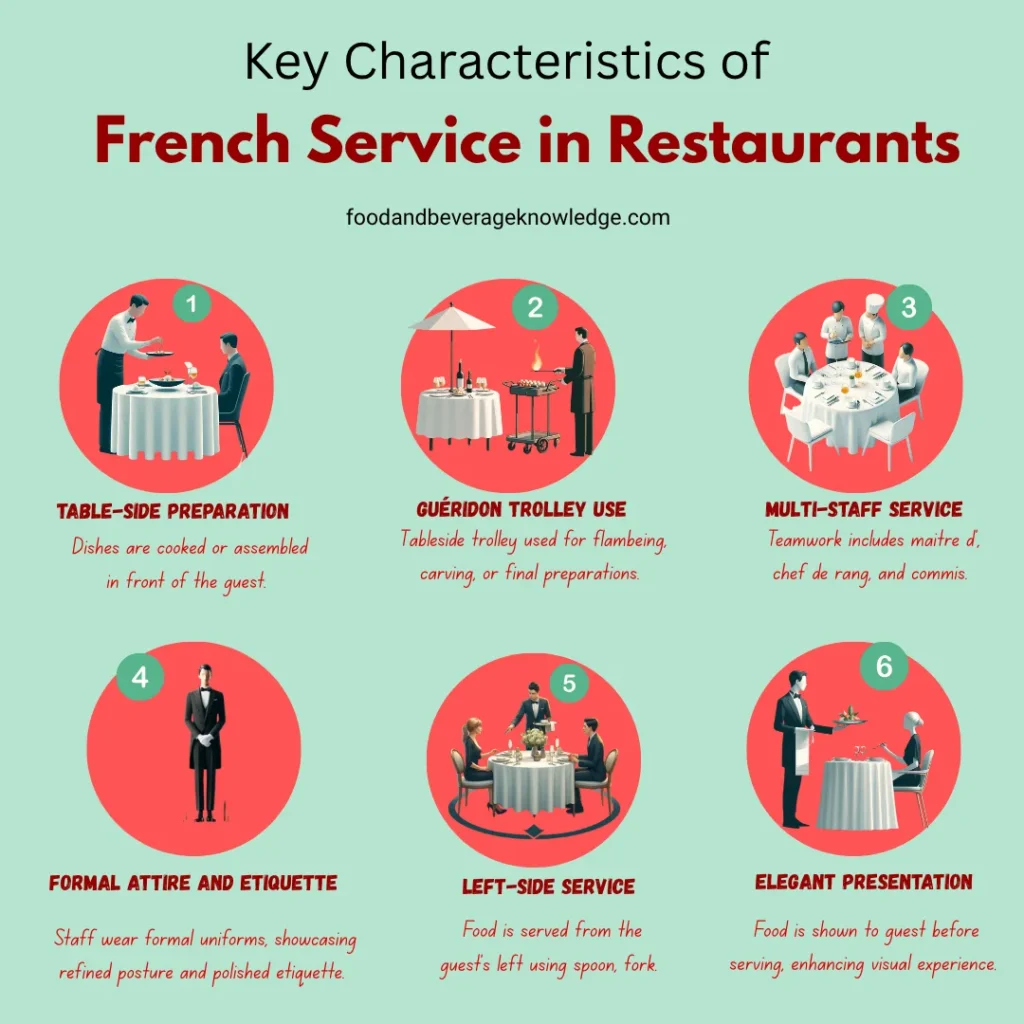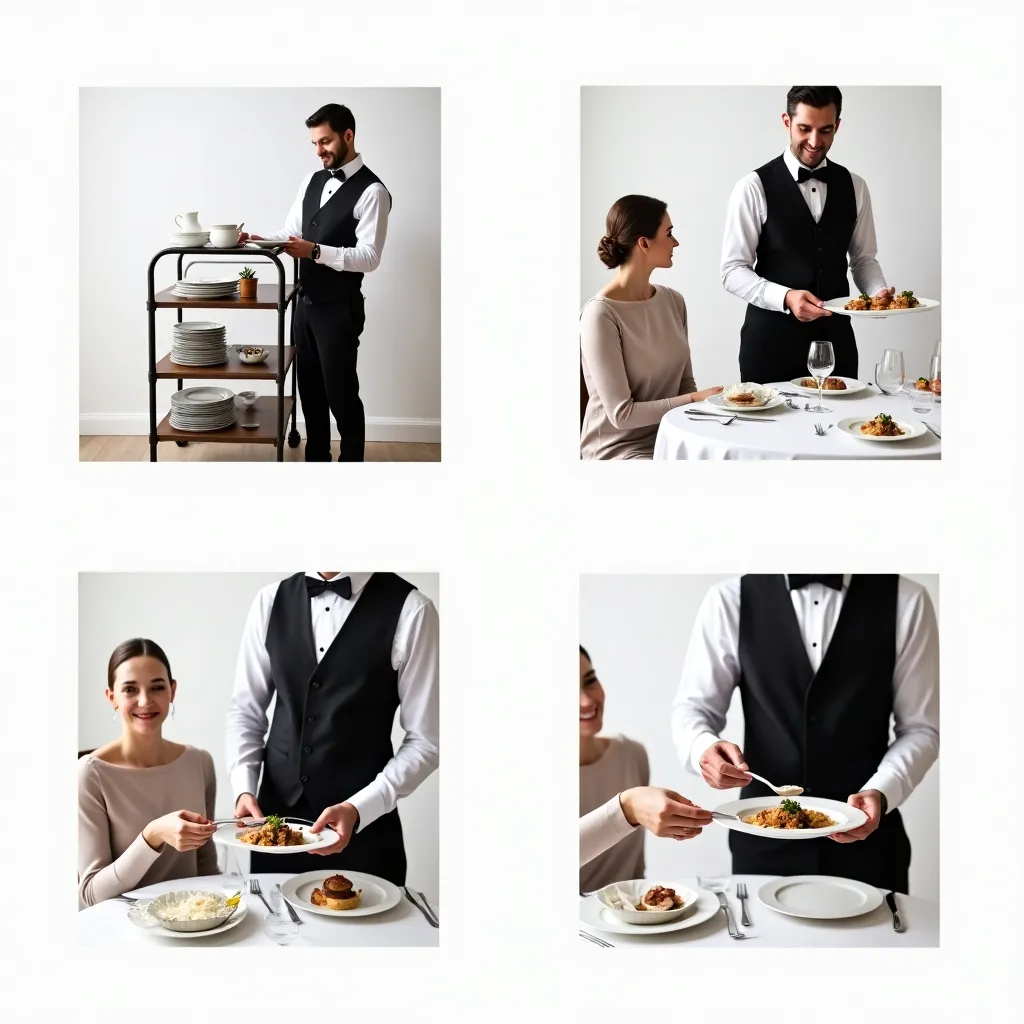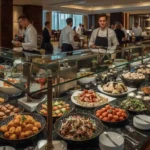French service is a classic and formal style of restaurant service where food is presented and served to guests at the table, often using a guéridon or service trolley. It emphasises elegance, precision, and personalised attention, making it a hallmark of fine dining.
Despite the rise of modern and fast-paced service styles like American service or Buffet service, French service continues to hold significant value in the hospitality industry, especially in luxury hotels, fine-dining restaurants, and formal banquets. For hotel management students, aspiring waitstaff, and food and beverage professionals, understanding French service is essential for building a strong foundation in high-standard guest service.
This article explores the history, characteristics, types, advantages, and modern relevance of French service, offering practical knowledge for both learning and professional development.
What is French Service?
French service (or Service à la Française) is a formal and elaborate restaurant service style where food is presented and served to guests directly at the table, often from a trolley or side station. The dishes are either plated in front of the guests or guests serve themselves from large platters that the server presents from the left side.
It often involves a guéridon trolley for table-side preparation or plating. Food is typically served from large platters using a service spoon and fork from the left side of the guest. This method emphasizes precision, presentation, and guest interaction. It requires highly skilled and synchronized service staff. French service is commonly seen in fine dining, luxury hotels, and formal banquets.
Origin of French Service
French service originated in the royal courts of France during the 17th and 18th centuries, especially under King Louis XIV. At the time, lavish meals were displayed all at once in a grand, ceremonial manner (Service à la Française). Guests helped themselves from an opulent spread of dishes, showcasing culinary wealth.
Over time, this evolved into a more structured, server-assisted service in restaurants. By the 19th century, it became popular in elite European dining rooms. It influenced other styles like Russian and English service. Today, its traditional elegance remains relevant in luxury hospitality. Many hotel schools still teach it as a core service method.
2. Key Characteristics of French Service
French service is distinctive in its elegance, attention to detail, and guest engagement. It’s more than just delivering food—it’s about presenting a performance.
Here are the core features:

- Elegant Presentation: Food is always presented to the guest before serving, allowing them to appreciate its appearance and ingredients. This adds a visual appeal and sense of ceremony to the dining experience. It highlights the care and craftsmanship behind each dish.
- Left-Side Service: Traditionally, food is served from the guest’s left using a service spoon and fork. Plates and used items are cleared from the right to maintain consistency. This standardised approach ensures smooth and professional service.
- Guéridon Trolley Use: A mobile service trolley, known as a guéridon, is used to prepare or finish dishes tableside. Common techniques include flambéing, carving meats, or tossing salads. It adds drama and elegance while keeping guests engaged.
- Table-Side Preparation: Certain dishes are assembled, garnished, or cooked in front of the guest. This performance-style service creates a luxurious and memorable experience. It requires skill, confidence, and precise coordination by the server.
- Formal Attire and Etiquette: Servers dress in formal uniforms and follow classic service etiquette. Every movement is controlled, respectful, and polished in execution. The demeanour reflects the high standards of luxury hospitality.
- Multi-Staff Service: French service often involves a team including a maître d’hôtel, chef de rang, and commis de rang. Each role has defined responsibilities to ensure efficient and flawless service. Teamwork and synchronisation are crucial for success.
- Guest-Centric Approach: The entire process focuses on making the guest feel valued and attended to. Interactions are warm but discreet, maintaining a refined environment. Personalisation and anticipation of needs are key features.
- Time-Intensive and Detailed: French service is slower than modern styles but rich in detail and quality. Each course is handled with care to deliver the best experience possible. It emphasises hospitality as both an art and a tradition.
3. Types of French Service
French service has evolved into several types over time, based on occasion, service style, and location. Below are the main types used in restaurants and banquets:
A. Cart French Service (Guéridon Service)
Also known as guéridon service, this is the most luxurious and interactive form of French service.
Key elements:
- Food is partially cooked or finished at the table.
- A guéridon trolley is used to hold portable cooking equipment, sauces, and cutlery.
- The maître d’hôtel or chef de rang performs tasks like flambéing desserts, carving meats, or assembling dishes in front of guests.
Examples:
- Steak Diane flambéed at the table
- Crêpes Suzette prepared and flambéed for dessert
B. Banquet French Service
This version is used in formal banquets and high-end events.
Characteristics:
- Multiple servers bring in platters of food and present them to guests.
- Guests serve themselves or are served by the staff using spoon and fork.
- Plates are not pre-set but are offered from platters.
Examples:
- State dinners, embassy banquets, and award functions
C. Butler Style (Silver Service)
Although sometimes categorised separately, Butler service or Silver service is heavily inspired by French service.
Distinctive points:
- The butler presents food from a large silver tray to guests using silver service cutlery.
- Food is served from the left, using a fork and a spoon.
- Often used in private dining or luxury hospitality settings
French Service Procedure

- Preparation of Side Station and Guéridon Trolley
- Equip the guéridon trolley with service tools (spoon and fork, service plates, flame burner, etc.).
- Organise prepared dishes, sauces, and ingredients needed for table-side service.
- Placing Service Equipment Near the Guest Table
- Position the guéridon trolley close to the guest’s table on the service side (usually the left).
- Ensure smooth access for carving, flambéing, or plating.
- Presentation of Dishes
- Bring the dish from the kitchen and present it to the guest from the left side before serving.
- Describe the dish briefly to enhance guest engagement and satisfaction.
- Table-Side Preparation or Finishing
- Perform any required finishing steps at the table (carving meat, flambéing, assembling salad, etc.).
- Use proper showmanship while maintaining safety and professionalism.
- Serving Food Using a Spoon and a Fork
- Use a service spoon and fork to transfer food from the platter to the guest’s plate.
- Always serve from the guest’s left side, in a graceful and synchronised manner.
- Serving Accompaniments Separately
- Offer sauces, vegetables, or side items separately from the platter or sauce boat.
- Pour or place accompaniments carefully, maintaining table-side elegance.
- Clearing Courses
- Clear used plates, cutlery, and glassware from the right side of each guest.
- Replace cutlery between courses as needed, ensuring a clean and ready setting.
- Crumbing the Table
- Use a folded napkin or crumb knife to remove crumbs from the table after the main course.
- Do this quietly and discreetly before dessert service begins.
- Dessert or Beverage Service from Guéridon (if applicable)
- Prepare or flambé desserts like Crêpes Suzette at the guéridon.
- Serve coffee, digestifs, or liqueurs to conclude the meal.
4. French Service vs Other Service Styles
Understanding how French service differs from other styles can help learners grasp its uniqueness and applications.
| Service Type | Main Features | Service Side | Formality |
|---|---|---|---|
| French Service | Food served tableside, finished at the guéridon | Serve from left | Very formal |
| English Service | Serve from the left | Serve from the right | Formal |
| Russian Service | Food is pre-plated in the kitchen | Serve from the right | Formal |
| American Service | Food is pre-plated in the kitchen | Fully prepared food plated by a waiter | Less formal |
| Buffet Service | Guests serve themselves | Self-service | The host serves guests, and the waiter assists |
5. Roles and Responsibilities of Service Staff
French service demands a team-oriented approach and a high level of skill from the service team. Here’s a breakdown of typical staff roles:
A. Maître d’hôtel (Head Waiter)
- Welcomes guests and manages the dining room
- Coordinates the entire service sequence
- Often performs high-skill table-side preparations
B. Chef de Rang (Station Waiter)
- In charge of a specific group of tables
- Takes orders, serves food, and manages guest experience
- Works closely with the commis and bus staff
C. Commis de Rang (Assistant Waiter)
- Assists the chef de rang
- Prepares the guéridon, fetches food from the kitchen, and handles mise en place
D. Sommelier (Wine Steward)
- Presents, recommends, and serves wine
- Integral to luxury French service settings
Training Requirements:
- Fine motor skills and control
- Table-side cooking techniques (e.g., flambéing)
- Exceptional guest communication and etiquette
6. Advantages and Disadvantages of French Service
Advantages:
- Elevated Guest Experience – Personal, theatrical service impresses guests
- Customisation at the Table – Food can be modified or enhanced in real-time
- Culinary Showcase – Displays skills of both kitchen and service staff
- Luxury Perception – Enhances the reputation of the establishment
Disadvantages:
- Time-Intensive – Slower service due to preparation at the table
- Requires Highly Skilled Staff – Not every server can execute it well
- Costly in Labour and Equipment – More staff and tools needed
- Not Suitable for high-turnover venues – Inefficient for casual or busy restaurants
7. When and Where to Use French Service
French service isn’t suitable for every setting. It is best suited for:
- Formal banquets and diplomatic events
- Gala dinners and VIP occasions
- Luxury fine-dining restaurants
- Wine-paired multi-course dinners
- Training modules in hospitality schools
Conclusion
French service, though traditional, is far from outdated. It continues to symbolise excellence in hospitality and is a hallmark of refined dining. For hotel management students and service professionals, learning the techniques of French service provides not only a historical perspective but also valuable skills in grace, professionalism, and guest interaction.
Related articles:
- Buffet Service in Food and Beverage: Types, Setup, and Best Practices
- What is Cafeteria Service? Definition, and Features for Hospitality Learners
- 19 Types of Banquet Table Setups: Choosing the Right Layout for Event
- 30 Most Common Interview Questions and Answers for Experienced Waiter/Waitress
- Types of food and beverage service outlets
FAQs About French Service
Q1: Is French service still used today?
Yes, especially in luxury hotels, formal banquets, and fine-dining restaurants.
Q2: What are some classic dishes served with French service?
Caesar salad, Chateaubriand, Crêpes Suzette, and Steak Diane.
Q3: How does French service differ from Russian service?
French service is performed tableside, while Russian service involves plating food on a sideboard before serving.
Q4: Can French service be adapted for modern restaurants?
Yes, elements like table-side cooking or flambéing can be incorporated as premium add-ons.
Q5: What should students focus on when learning French service?
Precision, spoon & fork handling, table-side prep, and team coordination.
Subscribe and join our community of hospitality professionals & students — get insights, tips, and the latest updates delivered straight to your inbox!







